The Reality of Bear Market Yield Farming
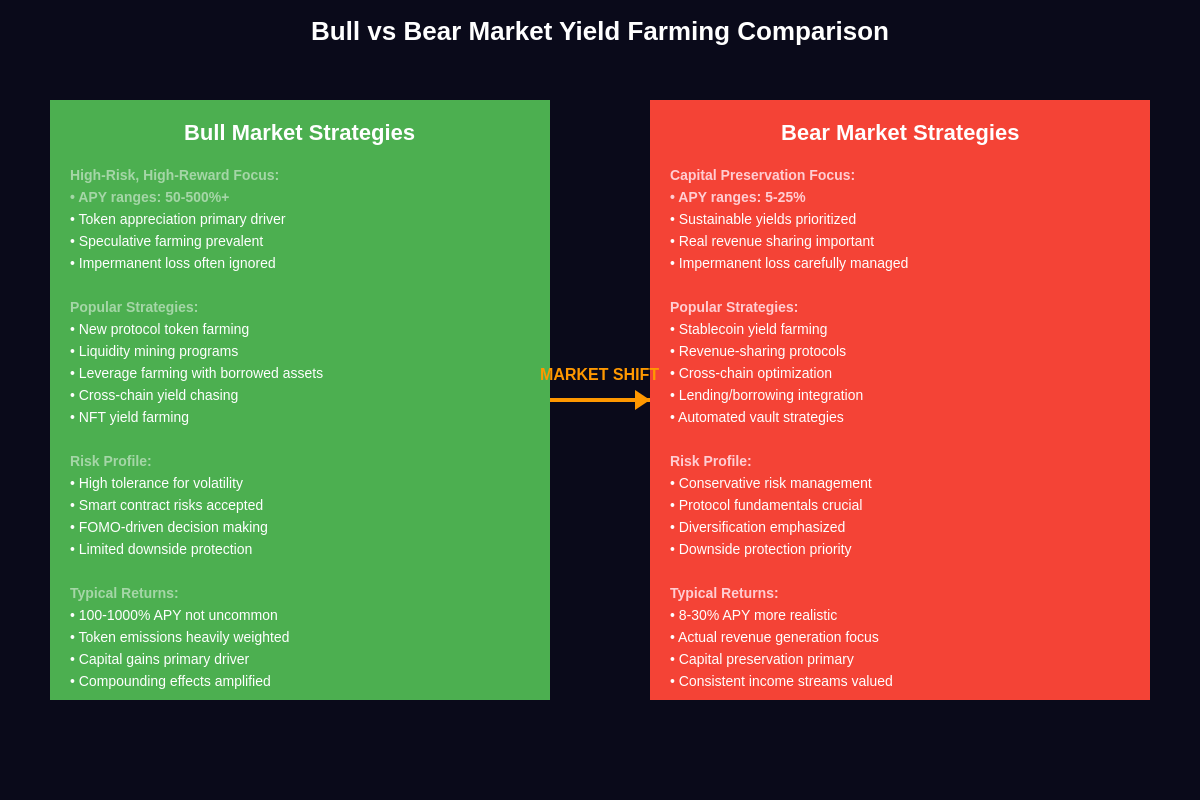
Bear markets present unique challenges and opportunities for yield farmers who understand how to navigate declining asset prices while maintaining consistent returns. Unlike bull market strategies that rely heavily on token appreciation, successful bear market yield farming requires a fundamental shift in approach, focusing on sustainable yields, risk management, and capital preservation rather than speculative gains. The key lies in identifying protocols that continue to generate genuine revenue streams even when overall market sentiment turns negative and trading volumes decrease significantly.
The traditional yield farming playbook often fails during bear markets because many protocols that offered attractive APYs during bull runs were essentially paying rewards in their native tokens, which depreciated faster than the yields could accumulate. Smart yield farmers recognize that bear markets separate legitimate DeFi protocols with real utility from those that were merely riding the wave of market euphoria. This market environment demands a more sophisticated understanding of tokenomics, protocol fundamentals, and risk-adjusted returns rather than chasing the highest advertised yields.
Experienced DeFi participants who have weathered multiple market cycles understand that bear markets often present the best opportunities for accumulating positions in quality protocols at discounted prices while earning yield. The reduced competition for farming opportunities, combined with more realistic token valuations, creates an environment where patient investors can build substantial positions that will appreciate significantly when market conditions improve. However, this requires careful protocol selection and a deep understanding of which projects will survive and thrive during extended downturns.
Stablecoin Strategies for Consistent Returns
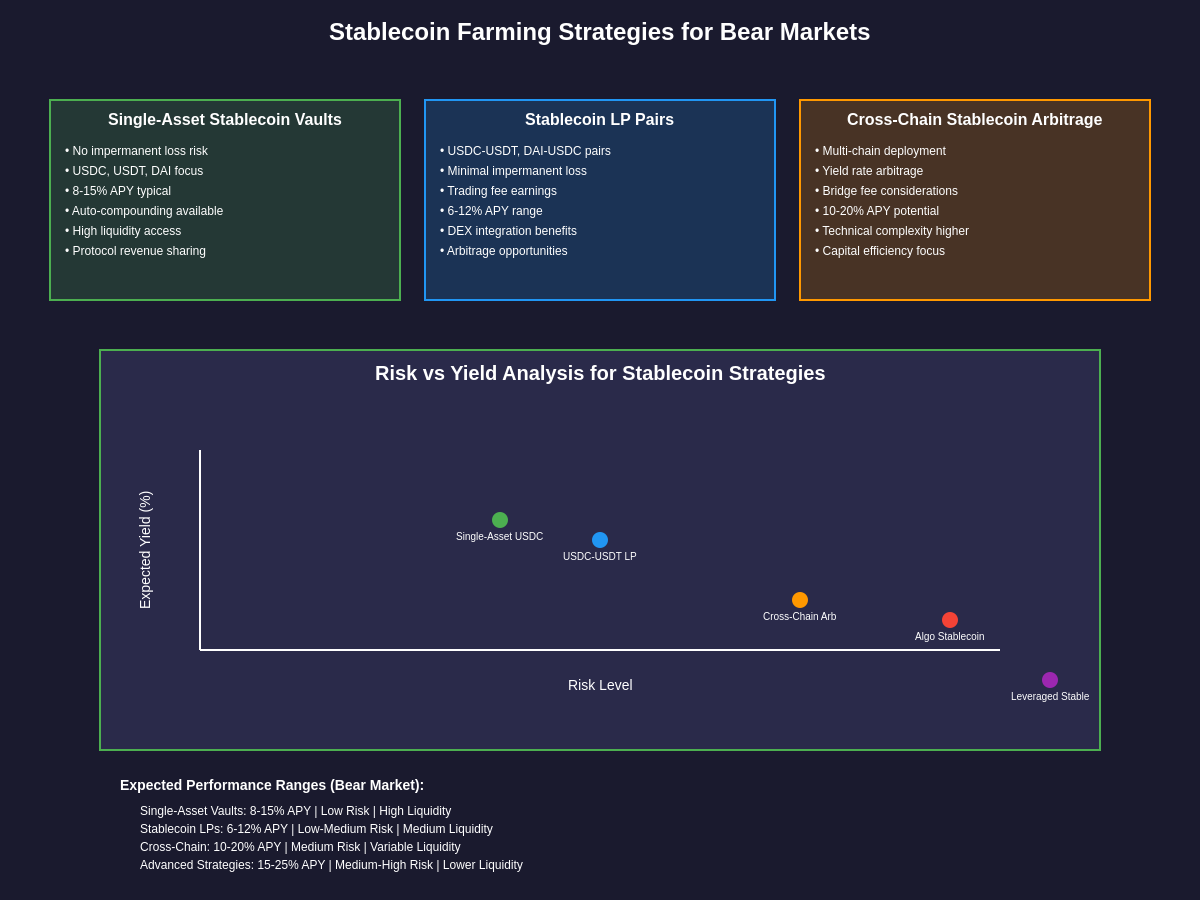
Stablecoin yield farming represents the cornerstone of bear market strategies, offering predictable returns without exposure to volatile cryptocurrency price movements. Professional yield farmers concentrate on stablecoin pools during bear markets because they provide consistent income streams while preserving capital value, allowing for strategic deployment when market conditions improve. The most effective approach involves diversifying across multiple stablecoin pairs and protocols to maximize yield while minimizing smart contract risks and regulatory exposure.
The landscape of stablecoin farming opportunities varies significantly between bull and bear markets, with bear markets typically offering higher yields on stablecoin pairs due to increased demand for stable assets and reduced supply of capital willing to farm these lower-risk opportunities. Sophisticated farmers analyze the underlying mechanisms that generate these yields, distinguishing between protocols that earn revenue from trading fees, lending activities, or other sustainable sources versus those that rely primarily on token emissions that may not be sustainable long-term.
Cross-chain stablecoin strategies become particularly valuable during bear markets as different blockchain ecosystems offer varying yield opportunities and risk profiles. Professional traders monitoring stablecoin yields across multiple chains can identify arbitrage opportunities and optimize their capital allocation to achieve the highest risk-adjusted returns. Layer 2 solutions often provide enhanced yields due to lower transaction costs, making it economical to compound returns more frequently and pursue smaller yield farming opportunities that would be unprofitable on expensive main networks.
Advanced stablecoin strategies involve utilizing different stablecoin types strategically, including algorithmic stablecoins, overcollateralized stablecoins, and centralized stablecoins based on market conditions and risk tolerance. During bear markets, some algorithmic stablecoins may trade at discounts to their pegs, creating opportunities for yield farmers who understand the mechanisms that restore parity and can profit from these temporary dislocations while earning additional yield from farming activities.
Protocol Revenue Sharing and Real Yield Opportunities
The concept of “real yield” has gained significant traction among sophisticated DeFi participants, particularly during bear markets when token emissions alone cannot sustain attractive returns. Protocols that share actual revenue generated from trading fees, lending activities, or other business operations with their token holders provide more sustainable and predictable income streams that are less dependent on continuous token appreciation. These opportunities become especially valuable during bear markets when speculative activities decrease but core DeFi activities like lending and borrowing continue.
Revenue-sharing protocols typically generate income through various mechanisms including decentralized exchange trading fees, lending protocol interest spreads, liquidation fees, and premium services offered to institutional users or advanced traders. The most successful yield farming strategies during bear markets focus on protocols with diversified revenue streams that remain robust even during periods of reduced market activity. Traders analyzing DeFi protocol revenues and token performance can identify protocols with strong fundamentals that continue generating income regardless of market conditions.
Governance token staking represents another avenue for earning real yield, particularly when protocols have established mechanisms for distributing actual revenue to token holders rather than merely inflating token supplies. During bear markets, governance tokens of established protocols often trade at significant discounts to their fundamental value, creating opportunities for yield farmers to acquire positions that will appreciate as markets recover while earning consistent income during the accumulation phase.
The timing of entry into revenue-sharing opportunities becomes crucial during bear markets, as protocols may adjust their fee structures or revenue distribution mechanisms in response to changing market conditions. Successful yield farmers monitor protocol governance proposals and treasury activities to anticipate changes that could affect yield generation and adjust their strategies accordingly.
Cross-Chain Yield Optimization Techniques
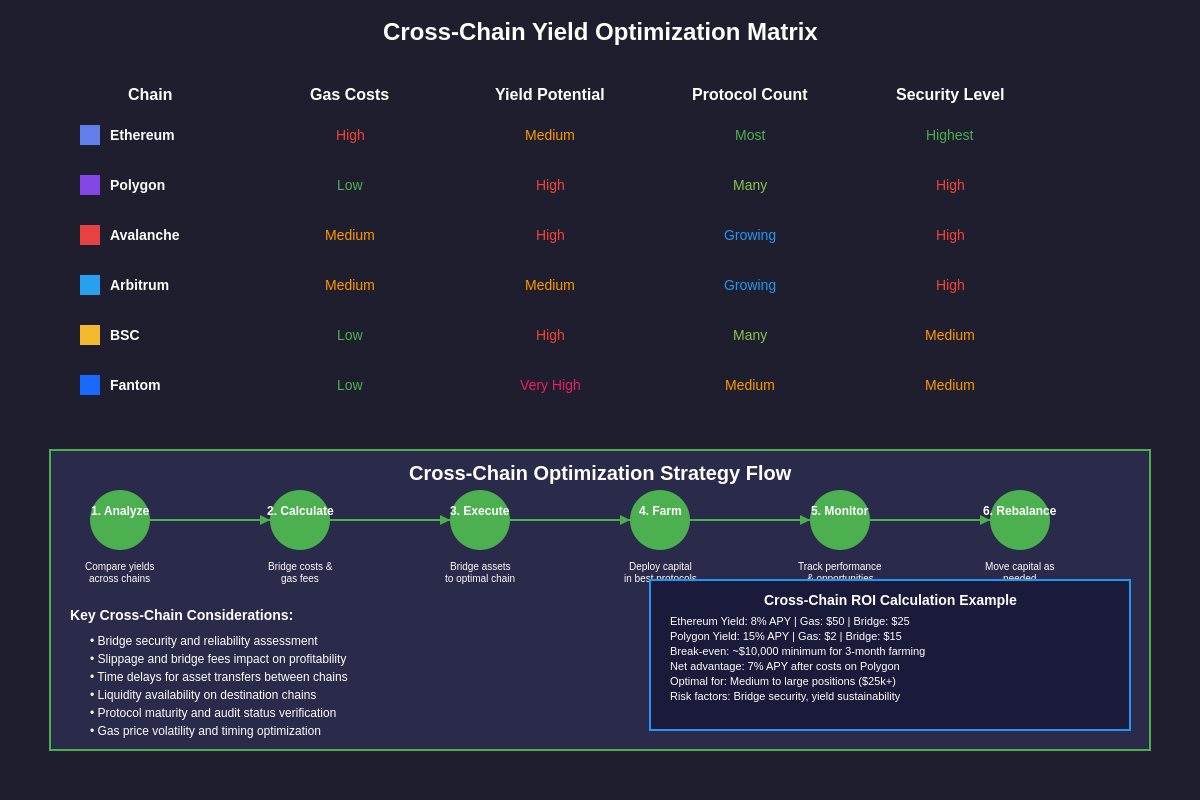
Cross-chain yield farming has evolved into a sophisticated strategy that becomes particularly valuable during bear markets when yield opportunities may be scarce on individual blockchains but abundant when considering the entire multi-chain ecosystem. Professional yield farmers develop expertise in navigating different blockchain networks, understanding their unique characteristics, fee structures, and available protocols to optimize their capital allocation across the most attractive opportunities regardless of which chain hosts them.
The technical infrastructure required for effective cross-chain yield farming includes understanding bridge mechanisms, managing multiple wallets across different networks, and calculating the true cost of moving assets between chains including bridge fees, gas costs, and time delays. During bear markets, these considerations become more critical as smaller yield differentials may not justify the costs and risks associated with cross-chain movements, requiring more sophisticated analysis to identify genuinely profitable opportunities.
Security considerations for cross-chain strategies intensify during bear markets as bridge protocols may face increased stress from reduced liquidity and potential attack vectors. Experienced yield farmers maintain diversified approaches that don’t rely heavily on any single bridge or cross-chain infrastructure, understanding that the convenience of moving assets between chains must be balanced against the additional smart contract risks and potential for catastrophic losses from bridge exploits.
Advanced cross-chain strategies involve monitoring yield differentials across chains and implementing systematic approaches to capture arbitrage opportunities while maintaining exposure to the most attractive long-term farming positions. Market participants utilizing comprehensive DeFi analytics platforms can track these opportunities across multiple protocols and chains simultaneously, enabling more efficient capital deployment and risk management.
Risk Management in Volatile Conditions
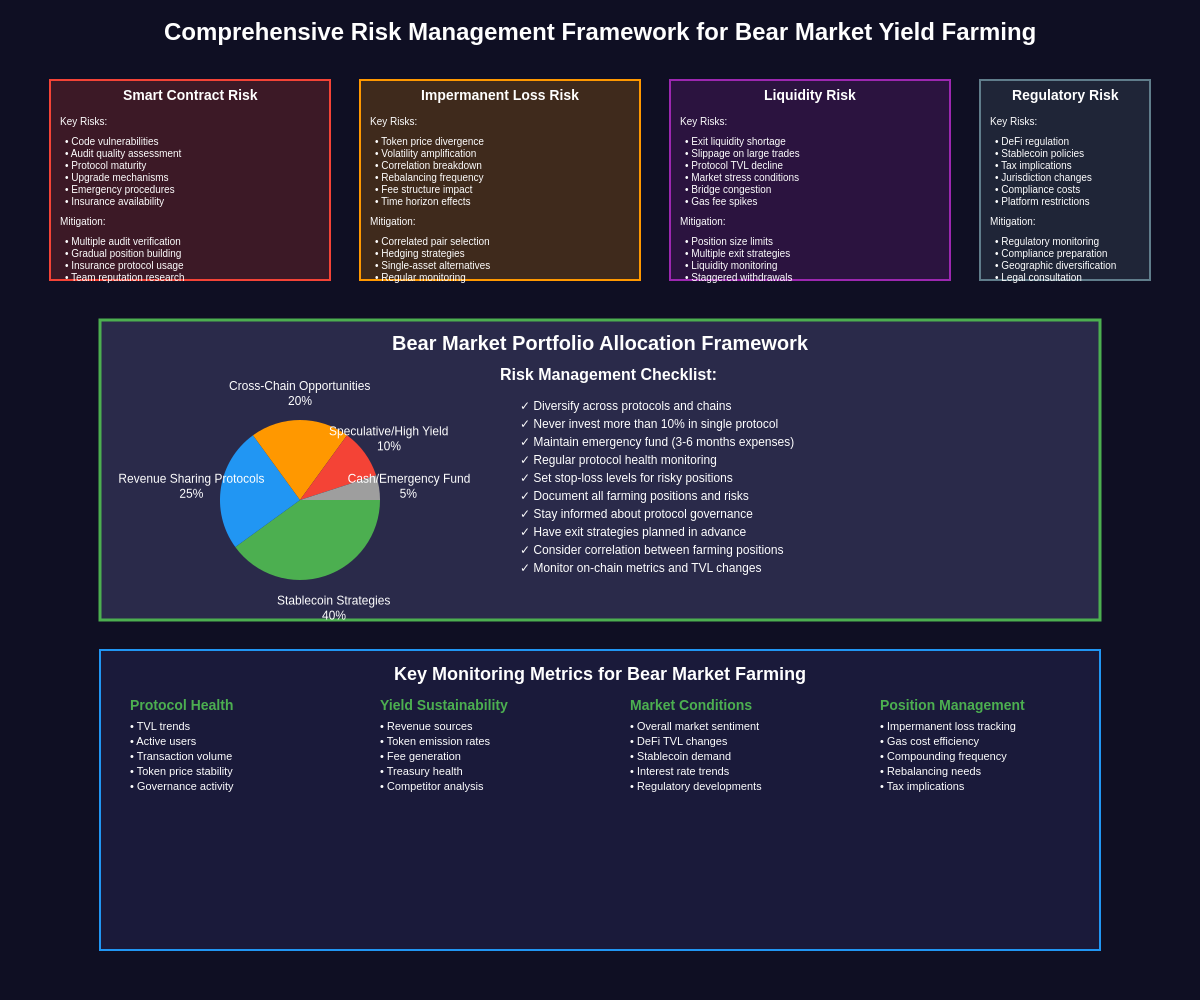
Bear market yield farming demands exceptional risk management practices as the margin for error becomes significantly smaller when asset prices are declining and yields may be compressed compared to bull market conditions. The most critical aspect involves position sizing and diversification strategies that can withstand extended periods of market stress while maintaining the ability to capitalize on opportunities that emerge during market downturns.
Impermanent loss management becomes even more crucial during bear markets as token prices may experience severe and prolonged declines that can overwhelm farming rewards if not properly hedged or managed. Sophisticated yield farmers employ various strategies including utilizing single-asset vaults when possible, maintaining hedged positions through derivatives, or selecting pairs with correlated assets that tend to move together during market stress, reducing the potential for significant impermanent loss.
Smart contract risk assessment intensifies during bear markets as protocols face increased stress testing from market conditions, reduced user activity, and potential changes in tokenomics or governance that could affect farming rewards. Professional yield farmers conduct thorough due diligence on protocol code audits, team credentials, treasury management, and governance structures to identify protocols most likely to survive and thrive during extended bear markets.
Liquidity risk management requires special attention during bear markets as reduced overall market activity can make it difficult to exit positions quickly if needed, particularly in smaller or newer protocols. Successful yield farmers maintain appropriate position sizes relative to available liquidity and diversify across protocols with different liquidity profiles to ensure they can adjust their strategies as market conditions evolve.
Hedging Strategies for Yield Farmers
Advanced yield farming during bear markets often incorporates sophisticated hedging strategies that allow farmers to maintain their farming positions while protecting against further downside in their underlying assets. These strategies become essential when farming attractive yields on volatile assets that could depreciate faster than the farming rewards can accumulate, effectively turning profitable farming operations into net losses if not properly hedged.
Options strategies provide powerful tools for yield farmers looking to maintain their positions while limiting downside risk, including protective puts on farmed assets, covered call writing to generate additional income, and collar strategies that limit both upside and downside while preserving farming yields. The key to successful options hedging lies in understanding the correlation between farming yields and options premiums, as market volatility affects both farming rewards and hedging costs.
Futures and perpetual contracts offer alternative hedging mechanisms that can be more capital-efficient than options for certain scenarios, allowing yield farmers to maintain delta-neutral positions that capture farming rewards regardless of underlying asset price movements. Professional traders monitoring crypto derivatives markets and funding rates can identify opportunities where futures premiums or funding rates provide additional yield on top of farming rewards, effectively creating leveraged yield strategies with managed risk profiles.
Cross-asset hedging strategies involve using different cryptocurrencies or traditional financial instruments to hedge yield farming positions, particularly valuable when direct hedging instruments are expensive or unavailable. These approaches require sophisticated understanding of correlation relationships and may involve hedging Bitcoin exposure with stock market indices or precious metals depending on market conditions and available instruments.
Lending and Borrowing Integration
Integrating lending and borrowing activities with yield farming creates opportunities for enhanced returns while managing risk during bear markets, particularly through strategies that utilize borrowed assets for farming activities while maintaining exposure to appreciating collateral assets. These leveraged yield farming strategies require careful management of liquidation risks and interest rate fluctuations but can significantly amplify returns when executed properly.
Recursive lending strategies involve depositing assets as collateral, borrowing against them, and then either farming the borrowed assets or redepositing them as collateral to borrow additional amounts, creating leveraged exposure to both lending yields and farming rewards. During bear markets, these strategies require conservative leverage ratios and careful monitoring of liquidation thresholds as asset prices may decline rapidly and unpredictably.
Stablecoin borrowing against cryptocurrency collateral enables yield farmers to maintain their long-term cryptocurrency positions while accessing capital for stablecoin farming opportunities, effectively allowing them to earn yield on both their collateral assets and the borrowed stablecoins. This strategy works particularly well during bear markets when stablecoin yields are elevated and cryptocurrency prices are depressed, providing opportunities to accumulate additional cryptocurrency positions through farming profits.
Interest rate arbitrage opportunities emerge when borrowing costs on one protocol are lower than lending or farming yields available elsewhere, creating risk-free profit opportunities for sophisticated yield farmers who can identify and execute these trades efficiently. These opportunities often arise during market stress when different protocols experience varying levels of supply and demand for their lending and borrowing services.
Automated Strategies and Vault Optimization
Automated yield farming strategies become increasingly valuable during bear markets as manual strategy management becomes more complex and time-sensitive when yields are compressed and risks are elevated. Professional yield management protocols offer sophisticated automation tools that can optimize strategies continuously, compound rewards efficiently, and adjust allocations based on changing market conditions without requiring constant manual intervention.
Yield aggregation protocols provide access to professionally managed strategies that diversify across multiple farming opportunities while minimizing gas costs through batched transactions and optimized smart contract interactions. During bear markets, these protocols often outperform individual farming efforts due to their ability to access institutional-grade strategies and negotiate better terms with underlying protocols through their larger capital pools.
Auto-compounding strategies become more critical during bear markets as transaction costs represent a larger percentage of farming rewards when yields are lower, making frequent manual compounding economically inefficient. Advanced vaults optimize compounding frequency based on gas costs, reward accumulation rates, and market volatility to maximize net returns after all expenses.
Portfolio rebalancing automation helps yield farmers maintain their desired risk profiles and allocation targets as market conditions change, automatically moving capital between strategies based on predefined criteria such as yield thresholds, risk metrics, or market indicators. Investors utilizing advanced portfolio tracking and analysis tools can implement sophisticated rebalancing strategies that respond to market conditions in real-time while maintaining their long-term investment objectives.
Token Accumulation During Market Downturns
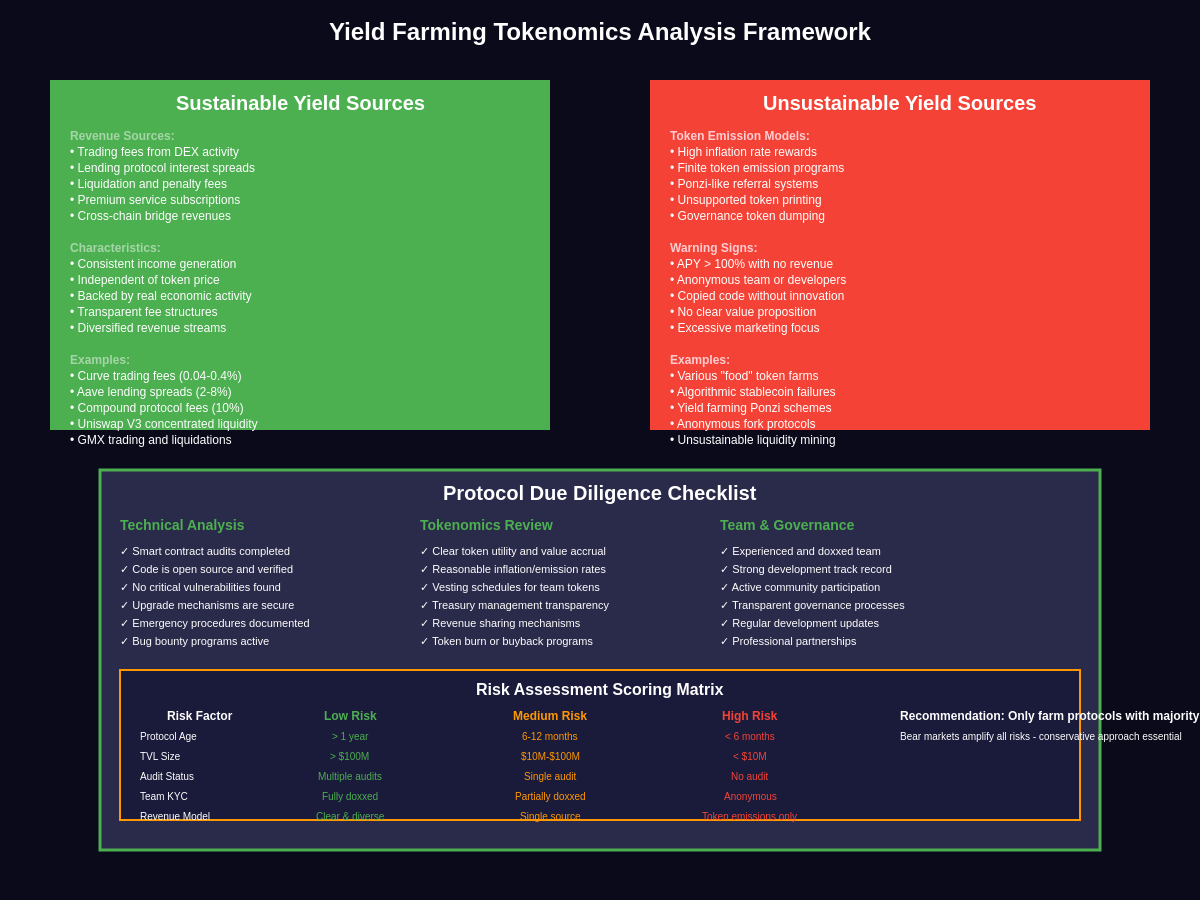
Bear markets present exceptional opportunities for yield farmers to accumulate governance tokens and protocol tokens at discounted prices while earning additional tokens through farming activities, creating a compounding effect that can generate substantial returns when market conditions improve. The key to successful accumulation strategies lies in identifying protocols with strong fundamentals that are likely to survive and thrive during the next market cycle while offering attractive yields during the accumulation phase.
Dollar-cost averaging through yield farming provides a systematic approach to building positions in promising protocols while generating income throughout the accumulation period, effectively reducing the average cost basis of accumulated tokens while earning additional rewards. This strategy works particularly well with protocols that offer consistent farming opportunities and maintain stable yields even during market downturns.
Strategic governance participation becomes more important during bear markets as protocols may implement significant changes to their tokenomics, fee structures, or strategic direction in response to challenging market conditions. Yield farmers who accumulate sufficient governance tokens can influence these decisions while earning additional rewards through governance participation, creating multiple value streams from their farming activities.
Ecosystem token accumulation strategies involve identifying entire blockchain ecosystems or protocol categories that are likely to benefit from long-term trends while temporarily trading at depressed valuations. Professional traders analyzing ecosystem token performance and development activity can identify undervalued opportunities where yield farming provides an efficient mechanism for building exposure while generating income during the accumulation phase.
Building Sustainable Income Streams
The ultimate goal of bear market yield farming extends beyond maximizing short-term returns to building sustainable income streams that can support long-term financial objectives regardless of market conditions. This requires developing diversified strategies that balance immediate income needs with long-term wealth accumulation while maintaining appropriate risk levels throughout various market cycles.
Income diversification across different DeFi protocols, blockchain networks, and yield generation mechanisms creates resilience against protocol risks, regulatory changes, and market volatility that could affect any individual income stream. Professional yield farmers typically maintain positions across lending protocols, liquidity provision, governance rewards, and revenue-sharing opportunities to ensure consistent income even if specific sectors experience difficulties.
Sustainable withdrawal strategies become crucial for yield farmers who depend on their farming income for living expenses or other financial obligations, requiring careful balance between compounding growth and income distribution to ensure long-term sustainability. These strategies must account for tax implications, market volatility, and the potential need to adjust withdrawals based on changing yield environments.
Long-term wealth building through bear market yield farming involves reinvesting farming profits into additional income-generating assets, diversifying beyond cryptocurrency into traditional investments, and maintaining emergency reserves to weather extended periods of market stress without compromising farming positions. Successful yield farmers understand that bear markets provide opportunities to build wealth that will compound significantly during the next bull market cycle.
Advanced Portfolio Construction
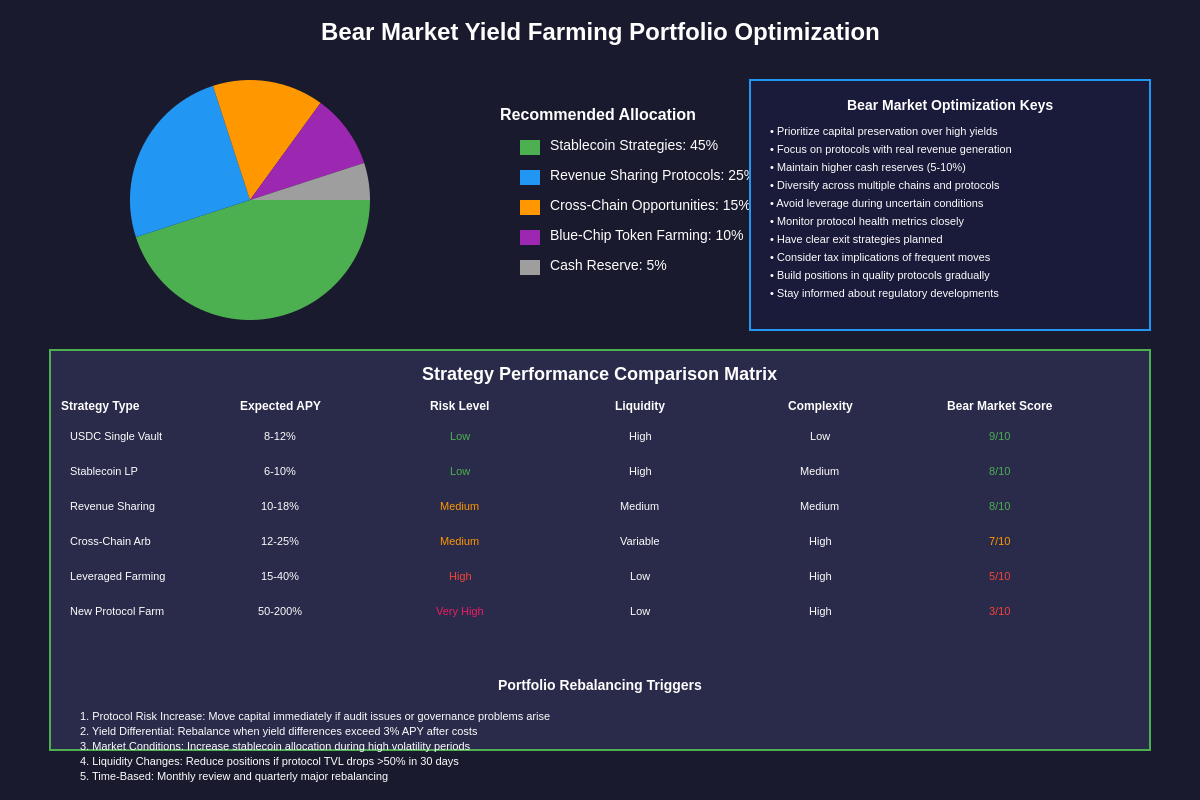
Professional yield farming portfolio construction during bear markets requires sophisticated understanding of correlation relationships between different DeFi protocols, blockchain networks, and underlying assets to create diversified positions that can generate consistent yields while managing downside risks. The most effective portfolios balance high-conviction positions in proven protocols with smaller allocations to emerging opportunities that could provide outsized returns if successful.
Risk-adjusted allocation strategies involve analyzing the historical performance, volatility, and correlation characteristics of different yield farming opportunities to construct portfolios that maximize expected returns for a given level of risk tolerance. During bear markets, these analyses become more critical as the margin for error decreases and the consequences of poor allocation decisions become more severe.
Dynamic rebalancing protocols help maintain optimal portfolio allocations as market conditions change and relative opportunities shift between different farming strategies, ensuring that capital remains deployed in the most attractive risk-adjusted yield opportunities available. Advanced portfolio managers utilize quantitative models that incorporate market conditions, protocol fundamentals, and risk metrics to guide allocation decisions systematically.
Performance measurement and optimization require sophisticated tracking of returns across multiple protocols, chains, and timeframes while accounting for all costs including gas fees, bridge expenses, and opportunity costs of capital deployment delays. Comprehensive performance analysis enables continuous improvement of yield farming strategies and identification of the most effective approaches for different market conditions.
Future-Proofing Yield Strategies
The rapidly evolving DeFi landscape requires yield farmers to develop adaptable strategies that can evolve with changing technology, regulations, and market conditions while maintaining consistent returns throughout various market cycles. Future-proofing involves building expertise in emerging technologies, maintaining flexibility in strategy implementation, and developing the analytical capabilities necessary to evaluate new opportunities as they emerge.
Technology adaptation strategies include staying informed about developments in cross-chain infrastructure, layer 2 scaling solutions, and new DeFi primitives that could create enhanced yield opportunities or disrupt existing farming strategies. Early adoption of promising new technologies can provide significant competitive advantages for yield farmers willing to invest the time and effort required to understand and implement new approaches.
Regulatory preparedness becomes increasingly important as governments worldwide develop frameworks for DeFi regulation that could significantly impact yield farming strategies and protocol operations. Professional yield farmers monitor regulatory developments and maintain compliance strategies that can adapt to changing requirements while preserving their ability to generate returns through legitimate DeFi activities.
Market evolution adaptation requires understanding how DeFi markets may mature and change over time, potentially requiring different strategies as institutional participation increases, yields normalize to traditional finance levels, and competition for farming opportunities intensifies. Successful long-term yield farmers develop skills and strategies that will remain relevant as DeFi markets mature and integrate more closely with traditional financial systems.
Professional traders and institutional investors require sophisticated technical analysis tools and real-time market data to navigate the evolving landscape of DeFi yield opportunities and implement strategies that can adapt to changing market conditions while maintaining consistent returns throughout various market cycles.
Disclaimer: This article is for educational and informational purposes only and should not be construed as financial advice. Yield farming involves significant risks including smart contract vulnerabilities, impermanent loss, and potential total loss of capital. DeFi protocols are experimental and may contain bugs or security flaws that could result in loss of funds. Past performance does not guarantee future results, and yield farming returns can be highly volatile and unpredictable. Always conduct your own research, understand the risks involved, and consult with qualified financial advisors before making investment decisions. The author and publisher are not responsible for any financial losses that may occur from acting on the information provided in this article.